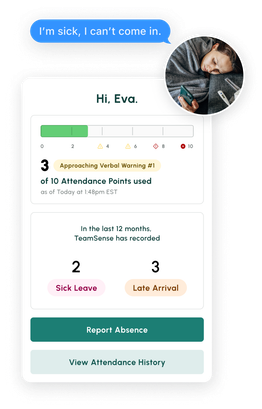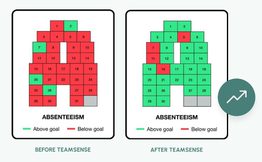Fix the root cause of No-Call No-Show with help from TeamSense
Table of Contents
- What is Employee Call-in or Call-out?
- What are Employee Call-in Procedures?
- Types of Employee Call-ins
- Employee Call-in Procedure: What to Include
- Simplify Employee Call-in or Call-off Procedures
- Employee Call-in Procedure Example
- Best Practices Implementing Employee Call-in Procedures
- How to Handle Employee Call-In Abuse & Policy Violations
Unplanned absences are a reality in any workplace, and the numbers tell the story. In 2022, the U.S. Bureau of Labor Statistics reported that 3.4% of manufacturing workers and 3.6% of warehousing employees were absent from work. But these numbers aren't just statistics: they represent real challenges that you, as an employer or supervisor, must navigate regularly.
So, what's the solution to this common challenge? A clear, well-defined employee call-in procedure. A great employee call-in procedure can be the difference between a timely, productive workforce and a mountain of no-call no-shows and shift changes to manage.
In this blog post, we'll delve into the types of employee call-ins, the important elements that make up a comprehensive call-in policy, and best practices for creating and implementing your employee call-in procedure. We'll also provide a call-in policy example you can work off of so you can improve your call-in procedures and ultimately reduce absenteeism at your organization.
Let’s begin!
What is Employee Call-in or Call-out?
Employee call-in or call-out refers to the process in which an employee notifies their employer or supervisor they are unable to attend work as scheduled or need to request time off for a specific period. These calls can be due to various reasons, such as illness, personal emergencies, medical appointments, or unexpected events.
Employees “call in” through designated communication channels, whether that be phone calls, emails, text messages, or absence management software.
TL;DR Summary of Effective Employee Call-In Procedures
- Clear Call-In Procedures: Essential for managing unplanned absences, reducing confusion, and maintaining smooth operations.
- Types of Call-Ins: Includes calling in sick, emergency call-outs, and scheduled absences, with procedures clearly outlined.
- FMLA Integration: Make sure employees know how to report FMLA leave properly, and ensure documentation is up-to-date.
- Effective Communication: Specify how, when, and to whom employees should report their absences, with options like phone, email, or text (e.g., TeamSense’s text-based system).
- Best Practices: Ensure the policy is accessible, train both employees and supervisors, and enforce it consistently for fairness.
- TeamSense Solution: Simplifies call-ins via text, ensures instant notifications, and helps track attendance, reducing absenteeism by up to 40%.
- Incentives and Compliance: Provide a fair appeal process and document all communications for transparency and legal compliance.
Understanding Different Terminologies
Ever been caught in the "call in" vs. "call off" vs. "call out" debate? They can be a bit of a puzzle, so let's clear that up
Call In
Traditionally, to "call in" means for an employee to notify their employer that they will not be able to attend work as scheduled. It's a proactive measure taken by the employee to inform their supervisor or designated contact point about their unexpected absence, often due to reasons like illness, personal emergencies, or other unforeseen circumstances. It's a term that underscores the responsibility on the part of the employee to communicate effectively.
Call Off
"Call off" is sometimes used interchangeably with "call in," but it can also be associated with the cancellation of work by the employer. For instance, if there's not enough work for the day or due to weather-related issues, an employer might "call off" a shift, indicating that the employee should not come in or that the workplace will be closed.
Call Out
While "call out" can also be used synonymously with "call in," it may have a different connotation in some regions or industries. In some cases, "call out" can imply the act of reporting an absence in a more urgent or unplanned situation, such as a last-minute emergency that prevents an employee from coming to work.
In a nutshell: Whether you're "calling in" with a heads-up or "calling out" in a crunch, what matters is you're keeping the lines of communication crystal clear. And if the day's "called off" by the powers that be, well, that's just a bonus. Just make sure your workplace handbook spells out these terms so everyone's singing from the same song sheet. No more mix-ups!
What are Employee Call-in Procedures?
An employee call-in procedure is a set of guidelines that employees should follow when they need to report an unexpected absence or a late arrival. They should cover who to call off to, when to call in by, and whatever information is required for HR to manage these requests. Having a clear and consistent call-in procedure can help employers manage their workforce, reduce employee no-call no-shows, and ensure compliance with labor laws.
It can also help employees understand their attendance responsibilities and avoid disciplinary actions or any misunderstandings.
Types of Employee Call-ins

Now that we’ve gone over the basics of what employee call-in means, we’ll now cover some reasons employees may need to call in.
Calling in Sick
This is one of the most common types of call-ins. Studies show that 72% of the total absence rate in 2022 was due to illness or injury. Employees might call in sick due to illness, injuries, or even stress.
Emergency Call Out
Emergencies can arise at any time, such as sudden family crises or medical emergencies.
Unscheduled Late Arrivals
Unscheduled late arrivals refer to instances when employees arrive at work later than their scheduled start time without prior notice or approval. An estimated 20 percent of workers are regularly late to work, costing U.S. businesses around $3 billion each year.
Scheduled Absences
While call-ins usually refer to unplanned absences, some organizations may still include instructions for reporting scheduled absences within their call-in policy. A scheduled absence refers to a planned and pre-approved time period during which an employee is not expected to be present at work. These absences may include vacations, personal days off, medical appointments, or other approved reasons for being away from work.
Incorporating FMLA into Call-In Procedures
Incorporating the Family and Medical Leave Act (FMLA) into your call-in procedures is about blending compassion with compliance. Here's how to weave it into your policy without getting tangled up.
Understanding FMLA Basics: FMLA allows eligible employees to take unpaid leave for specific family and medical reasons with the continuation of group health insurance coverage. When it comes to call-ins, employees should inform their employer as soon as possible if they need intermittent FMLA leave.
Seamless Integration: Start by training your team on FMLA essentials – who's eligible, how it works, and what rights and responsibilities both the employer and employee have. Ensure everyone knows that FMLA leave should be clearly stated when they call in, with details on the timing and expected duration of the leave if known.
Set Clear Expectations: Your call-in policy should specify how an employee can request FMLA leave. This includes who to contact, how much notice is required, and what information needs to be provided. For example, a simple sentence like, "If you're calling in for FMLA leave, please let us know immediately, and we’ll guide you through the next steps."
Document, Document, Document: Keep meticulous records of all FMLA call-ins. Documentation is your best friend in maintaining compliance and helping your team navigate their leave smoothly.
Be Proactive: Encourage employees to communicate their need for FMLA leave as early as possible. If it's foreseeable, a 30-day heads-up is ideal. If not, as soon as they can is the way to go.
Keep it Flexible: Sometimes life happens without warning. Be ready to handle last-minute FMLA call-ins with a process that's fair and understanding but still sticks to the legal script.
Remember, every workplace is unique, so tailor your FMLA call-in procedures to fit the fabric of your organization. And when in doubt, reach out to an HR professional or legal expert to ensure your policy is up to code.

Employee Call-in Procedure: What to Include
Now that we’ve covered some types of employee call-ins, we’ll review some important elements to include in an effective employee call-in procedure, such as how, when, and who to call in to.
Clear employee call-in procedures are essential for maintaining smooth operations and proper communication within an organization. These guidelines ensure that both employees and supervisors understand how to handle absences and unexpected situations.
Here's what to include in your employee call-in procedure:
1. How to Call In
Specify the methods through which employees should communicate their absence or unavailability. This can include:
Phone calls: Provide a dedicated phone number for employees to call and report their absence. Ensure this number is easily accessible and well-communicated to all employees.
Emails: If email communication is preferred, include a clear subject line and designated format for the email. This may include stating their name, reason for absence, and any other relevant details, or even a form that must be attached.
Attendance management apps: Some teams may require their employees to download attendance management apps. Just be aware that apps can get complicated, not all employees may feel comfortable using them on their personal phones, and some workers may not have smartphones.
Text messages: Text messaging is one of the most efficient and effective ways for employees to call off. An overwhelming 93% of employees prefer to use texting because it is easy to use. There’s no friction here because hourly workers already know how to use the technology (they’ve been texting for years). At TeamSense, we leverage the simplicity of texting to make lives easier for both you and your employees while building trust between all members of the team. And the results speak for themselves: our clients have a 100% adoption rate, zero complaints from employees, and are seeing close to a 40% reduction in rates of absenteeism.
Simplify Employee Call-in or Call-off Procedures
Employee call-in procedures are important for running frictionless operations and holding everyone accountable. A good call-in procedure needs to be easy to understand, allow prompt reporting of absences, and include fair rules.
TeamSense is the most user-friendly attendance management system that simplifies this entire process. We provide rapid rollout and 100% adoption, ensuring seamless integration that reduces no-call no-shows and prevents operational downtime.
We also support 19 different language translations, including English, Spanish, Hindi, Chinese, and Arabic, for a diverse team. What’s more? We can help you save over 3 hours per employee as you eliminate manual attendance tracking and complicated spreadsheets!
It just takes three simple steps:
Employees send a text
They fill out the short form they get back
The manager gets an instant alert
Implementing call-in procedures has never been easier. Choose seamless scheduling and higher productivity with TeamSense today.
If you’re looking for attendance-tracking software that’s easy to implement for both employees and team leaders, consider TeamSense. Our simple and universally understood channel – text messages – means you don’t have to worry about your non-tech-savvy employees.
2. When to Call In
In addition to explaining how to call in, you must also clearly define the timing for employees to report their absence:
Scheduled time offs: For planned time off and PTO tracking (vacations, appointments), detail how far in advance employees should submit their requests.
Early notification: Encourage employees to notify as early as possible before their scheduled shift, especially for unplanned absences. Specify a timeframe to allow for necessary adjustments.
3. Who to Call In To
In an organization without comprehensive call-in procedures, employees may call the wrong person – such as a fellow coworker or indirect manager – to make their report. A clear employee call-in procedure ensures that only the immediate supervisor or manager gets notified at the appropriate time.
Using a simplified absence management system allows your organization to properly enforce call-in procedures without the confusion of who to call. In fact, employees don’t have to call anyone at all! TeamSense’s text-based system makes it easy: employees report their absences by texting a predetermined number a word like “absent.” Once they do, the appropriate supervisor immediately gets notified so they can find coverage quickly and prevent downtime.
Yep, it can be that easy.
Employee Call-in Procedure Example
Since we’ve covered what to include in an employee call-in procedure, we also thought it would be helpful to provide an example you can use as call-off policy inspiration.
Policy Purpose
The purpose of this call-in procedure is to ensure effective communication between employees and management when an employee is unable to attend work as scheduled. Timely and accurate reporting of absences helps us maintain smooth operations and provide adequate staffing. All employees are expected to adhere to this procedure.
Reporting Absence
Timing: Employees are required to notify their supervisor or designated department as soon as they know they won't be able to attend their scheduled shift. For planned time off, notify at least 5 working days before the shift. For unexpected absences, notify at least 2 hours before the shift start time.
Method of Contact: Contact your supervisor directly using [state method of contact here, and any phone number or email address the employee needs to know].
Required Information
When reporting an absence, employees must provide the following information:
Your full name and employee ID.
The date and time of your scheduled shift.
The reason for your absence (e.g., illness, personal emergency, planned vacation).
If applicable, provide an estimate of when you expect to return to work.
If required, provide relevant documentation (e.g., medical certificate for illness).
Follow-up Communication
If you haven’t heard back from your supervisor about your absence, call their work phone number directly.
If your condition changes or you need to extend your absence, promptly inform your supervisor or the deputy.
Consequences of Non-Compliance
Failure to adhere to this call-in procedure may result in [add consequences, such as reduced pay, written warning, etc.]. Repeated violations may lead to further disciplinary actions.
Appeal Process
If you believe there are extenuating circumstances regarding your absence or the consequences imposed, you have the right to appeal. Contact [HR Department/Supervisor] to initiate the appeal process.
Record Keeping
All call-in communications and related documentation will be recorded and kept confidential in compliance with our company's privacy policies.
Note: This example can serve as a starting point, and you can customize it further to align with your company's policies, communication channels, and culture. Read further on how to write a complete employee attendance policy.
Best Practices Implementing Employee Call-in Procedures
So far, we’ve covered what employee call-in procedures are, what to include, and even a call-off policy example. But, implementing effective call-in procedures requires careful planning and communication.
Here are some best practices to consider:
1. Make It Clear & Comprehensive
Clear and comprehensive call-in procedures are the foundation of successful communication between employees and employers. Ensure that your call-in policy is well-documented, easily accessible, and accurately outlines every step employees need to take when reporting an absence or change in availability. Use simple language and provide examples to minimize confusion.
2. Work With Attendance Tracking Software
The right attendance tracking software can streamline the call-in process and enhance accuracy. These modern manufacturing software tools allow employees to report absences without manual paperwork, which improves the likelihood of employees submitting absences in advance and can keep information from getting lost or mixed up.
Attendance tracking software also provides:
Real-time updates: Supervisors can receive instant notifications about call-ins and respond promptly.
Data analysis: These tools can generate reports on attendance patterns, helping managers identify and address recurring issues.
Self-service Access: Employees can easily access the software from various devices, simplifying the reporting process.
If you’re looking for attendance-tracking software that’s easy to implement for both employees and team leaders, consider TeamSense. Our simple and universally understood channel – text messages – means you don’t have to worry about your non-tech-savvy employees.
3. Educate Employees & Supervisors on Your Call-out Policy
A call-in policy is only effective if employees and supervisors are well-informed about its details. Provide comprehensive training and resources to ensure that both employees and supervisors understand the importance of following the call-in procedures and are aware of the consequences of non-compliance.
Consider the following education strategies:
New employee orientation: Include call-in procedures as part of the onboarding process for new hires.
Regular reminders: Periodically communicate the call-in policy through company-wide announcements, meetings, or written reminders.
Supervisory training: Train supervisors and managers on how to handle call-ins, including appropriate responses, documentation, and follow-up.
4. Enforce Call-in Procedures Fairly and Consistently
Consistency in enforcing call-in procedures is essential to maintain a fair and respectful work environment. Inconsistent enforcement can lead to morale issues, resentment, and potential legal concerns. Steps to ensure fair and consistent enforcement:
Establish consequences: Clearly outline the consequences of failing to follow call-in procedures, ensuring they are applied uniformly.
Review process: Implement a process for employees to appeal decisions related to call-in violations or consequences.
Document incidents: Keep detailed records of call-in incidents, including communication, responses, and any actions taken.
How to Handle Employee Call-In Abuse & Policy Violations
Having a well-defined call-in policy is essential for managing absences, but what happens when employees start abusing the system? Whether it’s frequent last-minute call-ins, a pattern of absences before weekends, or employees using sick leave dishonestly, these issues can disrupt operations, create scheduling chaos, and lower team morale.
To prevent abuse while maintaining fairness, here’s how to proactively address repeat call-in violations and ensure accountability:
1. Identify Patterns of Abuse
Not all absences are equal. Some employees may have genuine reasons for calling in, while others take advantage of the system. To spot abuse, watch for:
Frequent last-minute call-ins – Are certain employees consistently calling in sick right before a shift starts? This makes it harder to adjust schedules and find replacements.
Absence patterns around weekends & holidays – Do they frequently call in on Mondays, Fridays, or right before/after a long weekend? This could indicate intentional misuse.
Excessive use of FMLA or sick leave – If an employee consistently calls in under FMLA or uses all available sick leave as soon as it resets, review documentation to ensure compliance.
Tracking these trends can help employers differentiate between legitimate absences and repeat offenders who may be gaming the system.
2. Implement Progressive Discipline
A structured and fair disciplinary process ensures that employees are held accountable while giving them opportunities to correct their behavior. Consider using a progressive discipline approach:
First offense → Verbal warning (with documentation). A simple conversation to remind the employee of attendance expectations.
Second offense → Written warning that outlines policy expectations and consequences of continued violations.
Third offense → Probation or suspension, depending on company policy and the severity of the absenteeism.
Final step → Termination, if attendance violations persist despite multiple warnings.
Employers should clearly communicate this process and document every step to ensure transparency and legal protection.
3. Use Attendance Tracking to Encourage Accountability
An absence tracking tool like TeamSense can help HR teams and managers monitor trends, detect call-in abuse early, and provide objective data when discussing attendance issues.
Benefits of digital tracking:
Instantly notifies managers when an employee calls in.
Provides real-time attendance data to identify problematic patterns.
Creates an audit trail for documentation and compliance.
By automating absence tracking, employers can focus on correcting behaviors rather than constantly playing detective with employee attendance.
4. Ensure Compliance with Labor Laws
While it’s important to enforce attendance policies, employers must also ensure they’re following federal and state labor laws to avoid legal pitfalls.
Align with state & federal regulations – Ensure discipline policies comply with labor laws like the Family and Medical Leave Act (FMLA), the Americans with Disabilities Act (ADA), and state-specific sick leave laws.
Apply rules fairly – Attendance policies must be enforced consistently across all employees to prevent claims of favoritism or discrimination.
Give employees a chance to explain – Before issuing formal warnings or discipline, allow employees to provide legitimate reasons or supporting documentation for their absence.
A clear, fair, and legally sound call-in policy protects both the business and its employees while reducing absenteeism.
Addressing call-in abuse doesn’t mean punishing employees for being sick—it’s about creating clear expectations, fair enforcement, and proactive solutions to minimize disruptions. By tracking attendance patterns, implementing progressive discipline, and leveraging digital tools like TeamSense, employers can reduce absenteeism, improve accountability, and keep operations running smoothly.

Is your call-in process terrible? Text reduces no-shows and absenteeism by up to 40%.
Don't believe us? Check out this case study to see how this 3PL benefited.

Boosting Efficiency: A 3PL Company Slashes Absenteeism by 39% with TeamSense
TeamSense changed the way this 3PL handled absenteeism, resulting in significant improvement in absenteeism rates, and can help your company too!
About the Author

Sheila Stafford, CEO of TeamSense & AI in HR Innovator
As CEO of TeamSense, Sheila Stafford is at the forefront of transforming HR for frontline teams through AI-driven solutions. With a commitment to enhancing employee relations and simplifying workforce management, Sheila leads TeamSense in pioneering advancements that empower both frontline employees and HR teams. Her visionary approach combines cutting-edge technology with a thoughtful focus on enhancing human connection; Sheila strategically implements AI where it adds the most value while recognizing the critical role of personal interaction and ensuring that human engagement remains central when it matters most. Under her leadership, TeamSense is redefining how companies support and engage their frontline teams for a more connected, efficient workplace.





